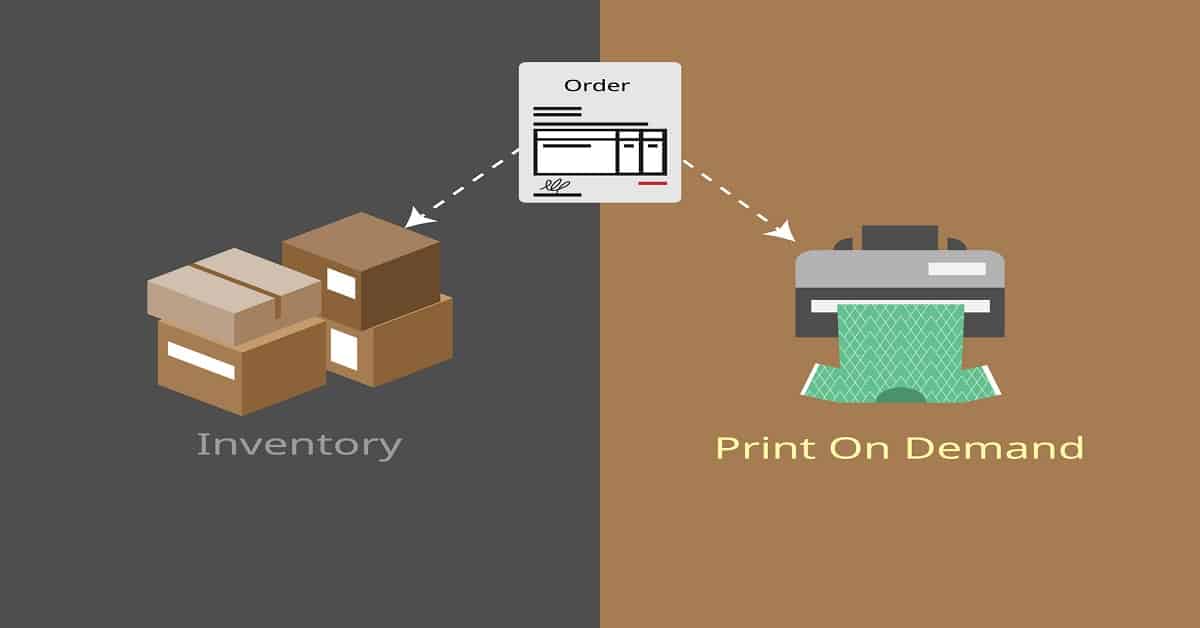Dropshipping vs Print on Demand – A Business Guide for Beginners

I. Introduction
Welcome to an in-depth exploration into the world of entrepreneurship, specifically focusing on dropshipping vs. print on demand – two popular e-commerce business models that have been gaining significant attention in recent years.
For beginners, understanding the nuances and potentials of both the dropshipping vs. print-on-demand models can be an intimidating task. However, in this guide, we will demystify these concepts, providing a clear, actionable roadmap for aspiring entrepreneurs to set up and scale their e-commerce ventures.
Whether you choose to dive into dropshipping or venture the print-on-demand route, both models offer a unique set of advantages and challenges. Filled with insights on niche selection, online store setup, content marketing strategies, and SEO for e-commerce, this guide aims to equip you with the knowledge and tools to start and grow your business successfully.
Let’s embark on this entrepreneurial journey of dropshipping vs. print on demand. Specifically navigating through e-commerce platforms, branding tips, and business scaling techniques, right down to handling competition and legal issues in the online business world.
II. Choosing Your Dropshipping Business Model
A. Explaining Dropshipping
1. How a Dropshipping Business Works
A dropshipping business is an e-commerce model that allows store owners to sell products without stocking or owning inventory. As a dropshipping business owner, you list products on your online store, and when an order is placed, you purchase the item from a third-party supplier who then ships the product directly to the customer. Essentially, your primary roles are marketing and customer service – the supplier handles the rest.
2. Pros and Cons of Dropshipping
The advantages of a dropshipping business include low startup costs, as there’s no need to purchase inventory up-front, and a wide selection of products to sell since you’re not limited by storage space. It’s a versatile business model that allows for easy scalability and global reach. However, the disadvantages include lower profit margins due to competition, reliance on third-party suppliers for inventory and shipping, and less control over shipping times and product quality than other business models.
B. Understanding Print-on-Demand
1. Overview of Print-on-Demand
Print on Demand (POD) is another e-commerce model that involves printing custom designs on products only after a customer has placed an order. This business model is popular for customized products like t-shirts, mugs, or posters. As a POD merchant, you focus on the design and marketing of your product, while a third-party supplier handles the printing and shipping.
2. Pros and Cons of Print on Demand
The advantages of Print on Demand companies include no inventory costs and the ability to offer customized print-on-demand products, making it a great option for artists and designers. It also allows you to test designs and products without a significant investment. The disadvantages include lower profit margins due to the cost of individual production, dependency on suppliers for printing and shipping, and limitations on the types of products that can be printed on.
C. Decision-Making Criteria
1. Skills and Interests
When deciding between dropshipping vs. print-on-demand, consider your skills and interests. If you have a knack for spotting trending products and excellent marketing skills, dropshipping may be for you. On the other hand, if you’re a creative person with unique design ideas, POD could be a better fit.
2. Budget and Resources
Another crucial factor when deciding between dropshipping vs. print-on-demand is your budget. While both models have low startup costs, dropshipping might require a slightly higher investment to purchase products from suppliers. POD, however, will require more time and resources spent on design. Evaluate your budget, time, and resources to make an informed decision that aligns with your business goals.
III. Market Research
A. Identifying a Niche
1. Tools and Methods for Niche Research
Identifying a profitable niche is the cornerstone of a successful dropshipping or print-on-demand business. Therefore, tools like Google Trends, Keyword Planner, SEMrush, and Ahrefs can provide valuable insights into market trends, search volume, and competitive analysis. Also, these tools help identify high-demand, low-competition niches. Apart from these, forums like Reddit, Quora, and social media platforms can offer insights into popular trends and consumer interests.
2. Examples of Profitable Niches
Examples of profitable niches in dropshipping vs. print-on-demand include sustainable products, fitness and wellness, personalized items, pet supplies, and beauty and skincare. However, remember that success in these niches depends on your ability to offer unique, high-quality products and devise effective marketing strategies.
B. Analyzing Competition of Dropshipping vs. Print on Demand
1. Competitor Research Techniques
Understanding your competition is crucial to identifying opportunities and understanding market dynamics. Therefore, tools like SEMrush and SimilarWeb can provide comprehensive data about your competitors’ website traffic, top-performing products, and marketing strategies. Additionally, scrutinizing their social media platforms can offer insights into their customer engagement strategies and brand messaging.
2. Evaluating Market Saturation
Market saturation refers to the extent to which a product or service is already common in the market. A saturated market can pose challenges due to high competition, but it also indicates high demand. Use tools like Google Keyword Planner and Ahrefs to evaluate the competitiveness of your chosen niche. So a good strategy is to find a balance between demand and competition.
C. Target Audience of Dropshipping and Print on Demand
1. Creating Customer Personas
Since customer personas are fictional representations of your ideal customers. All in all, based on market research and real data about your existing customers. Therefore, they help in understanding the needs, behaviors, and pain points of your target audience. So, these personas should include demographic information, interests, buying behavior, and motivations and challenges.
2. Understanding Customer Needs and Preferences
Understanding your target audience’s needs and preferences is crucial to tailor your product offerings and marketing strategies. Hence, this can be achieved by conducting surveys, collecting customer feedback, monitoring social media conversations, and analyzing customer reviews and comments. Overall, knowing your customers’ needs and preferences enables you to create a value proposition that resonates with them and differentiates you from your competitors.
IV. Setting Up Your Business
A. Legal Considerations for Dropshipping vs. Print on Demand
1. Business Registration and Permits
Before you launch your dropshipping or print-on-demand business, it’s essential to register it with the appropriate local or national authorities. Also, depending on your location, the process may involve obtaining a business license, registering for a tax identification number, or even securing specific permits. So, consult with a legal expert or a local business agency to identify all necessary requirements.
2. Tax Obligations
Running an online business comes with tax obligations that you must fulfill. For example, these may include sales taxes, income taxes, and potentially import taxes if you’re sourcing products internationally. Tax laws vary significantly from one country to another, and even between states or regions, so it’s vital to understand your tax obligations or consult with a tax expert.
B. E-Commerce Platform for Online Store
1. Comparing Platforms
While there are numerous e-commerce platforms to choose from to sell online, including Shopify, WooCommerce, BigCommerce, and more. When comparing platforms, consider factors such as ease of use, payment options, SEO capabilities, customer support, and pricing plans. So, be sure to select a platform that fits your business needs and supports dropshipping or print-on-demand functionality.
2. Setting Up Your Online Store
Once you’ve chosen a platform, it’s time to set up your own online store. Basically, this includes choosing a professional and catchy store name. In addition to customizing your website’s appearance to align with your brand. Also, setting up product categories, and configuring payment and shipping options.
C. Sourcing Products (Dropshipping)
1. Finding Reliable Suppliers
Reliable suppliers are the backbone of successful dropshipping companies. Therefore you can find suppliers through dropshipping directories, online marketplaces, or industry trade shows. Remember to evaluate potential suppliers on their product quality, delivery times, communication skills, and reputation before settling on one.
2. Product Selection
Since product selection is a crucial step in setting up your dropshipping store. Choose products that align with your niche. Also, ones that have a proven demand, and can generate a reasonable profit after accounting for costs.
D. Product Creation (Print on Demand)
1. Design Considerations
Design is a critical aspect of a successful print-on-demand business. Your designs should be unique, appealing, and aligned with your brand. They should also cater to your target audience’s tastes and preferences. Utilize design tools and software to create eye-catching designs.
2. Choosing a Print Provider
Obviously, choosing the right print provider is vital in a print-on-demand business. So, some popular print-on-demand services include Printify, Printful, and Zazzle. Consider factors such as the range of products they offer, printing quality, pricing, shipping options, and customer service when selecting a provider.
V. Building a Brand
A. Branding Essentials for Dropshipping and Print on Demand
1. Logo and Visual Identity
Your logo and visual identity are essential components of your brand, contributing significantly to how your company is perceived. Your logo should be simple, memorable, and reflective of your brand values. Meanwhile, your visual identity – encompassing color schemes, typography, and imagery – should be consistent across all marketing materials and platforms, creating a unified and recognizable image.
2. Brand Voice and Messaging
Your brand voice is the persona and emotion infused into your company’s communications. It should be consistent and reflect your brand values and target audience. Your messaging, on the other hand, conveys your brand’s value proposition and unique selling points. It should be clear, compelling, and tailored to your customers’ needs and interests.
B. Creating a Professional Website for Dropshipping or Print on Demand
1. Design Tips and Best Practices
The design of your website should echo your brand identity, be visually appealing, and facilitate conversions. Therefore, utilize whitespace for readability. Also, use high-quality images, and ensure your color scheme promotes a positive user experience. In addition, keep your design simple and clean, with clear calls-to-action and easy-to-read fonts.
2. User-Friendly Navigation
A user-friendly website is easy to navigate. So, make the user journey from homepage to purchase as seamless as possible. Also, ensure your website structure is logical, with a clear menu, responsive design, and a search function. Fast loading times, mobile optimization, and a straightforward checkout process can also enhance user experience.
C. Content Marketing for Both Dropshipping and Print on Demand
1. Blogging, Social Media, and Email Marketing
Content marketing is a powerful way to attract and engage your audience. Therefore regularly publish informative and engaging blog posts, and share content on social media platforms. Also, use email marketing to keep your customers informed about new products or special offers. Altogether, each of these channels allows you to provide valuable content to your audience, fostering relationships and promoting customer loyalty.
2. SEO Strategies for Visibility
Implementing SEO strategies can significantly enhance your website’s visibility on search engines. Basically, this includes keyword optimization, creating high-quality backlinks, optimizing meta tags and images, and regularly updating content. SEO is a long-term strategy, but it can significantly boost your organic traffic and increase your website’s credibility and visibility, thereby enhancing your chances of attracting and converting potential customers.
VI. Marketing and Sales Strategies
A. Paid Advertising
1. Google Ads, Facebook Ads, etc.
Investing in paid advertising platforms like Google Ads and Facebook Ads can help you reach a larger audience and drive more traffic to your online store. Google Ads allows you to bid on specific keywords and display your ads in Google’s search results, while Facebook Ads enables you to target specific demographics and interests. Both platforms require careful keyword research and targeting to ensure your ads reach your intended audience.
2. Budget Allocation and ROI Tracking
Since budget allocation is a critical aspect of your paid advertising strategy. You should allocate your budget based on the platforms that deliver the highest return on investment (ROI). So, regularly track and measure the performance of your ads to identify which ones have the highest ROI. Then, use this information to optimize your ad spend and improve campaign performance.
B. Organic Traffic
1. Search Engine Optimization (SEO)
SEO is a cost-effective strategy to attract organic traffic to your website. However, it involves optimizing your website content and structure to rank higher in search engine results. Specifically, this includes keyword optimization, creating quality content, and building authoritative backlinks. SEO is a long-term strategy but can significantly increase your online visibility and attract high-quality traffic.
2. Content Marketing for Organic Growth
Content marketing is another effective way to generate organic traffic. It involves creating and sharing valuable content that attracts and engages your audience. Also, this can include blog posts, videos, infographics, and more. Therefore, high-quality, relevant content can improve your SEO, build brand credibility, and encourage customer engagement and loyalty.
C. Social Media Marketing
1. Leveraging Platforms for Promotion
Social media platforms like Instagram, Facebook, and Pinterest can be powerful marketing tools for your e-commerce business. So, choose the platforms that align best with your target audience and product niche. Also, utilize these platforms to showcase your products, share engaging content, and promote special offers or events.
2. Engaging with the Audience
Engagement is key in social media marketing. Therefore, regularly interact with your followers by responding to comments, asking for feedback, and encouraging user-generated content. This not only strengthens your relationship with your audience but also increases your brand visibility and credibility. Also, remember, that social media is a two-way communication channel. So, listening and responding to your audience is as important as promoting your brand and products.
VII. Order Fulfillment and Customer Service
A. Order Management and Tracking
1. Handling Orders Efficiently
Effective order management is the backbone of a successful dropshipping or print-on-demand business. All in all, this involves handling orders from their initial receipt through to the final delivery in a timely and efficient manner. So, utilize a reliable order management system to track orders, maintain accurate inventory levels, and automate order processing. Generally, this reduces the likelihood of errors and enables you to fulfill orders quickly, thereby enhancing customer satisfaction.
2. Addressing Shipping Issues
Shipping issues, such as shipping costs, delays, or lost packages, are inevitable in e-commerce, but proper management can minimize their impact. Therefore, establish clear shipping policies, provide customers with tracking information, and work closely with your shipping providers to resolve issues promptly. Also, if a shipping issue does occur, communicate honestly and quickly with your customers to keep them informed and manage their expectations.
B. Customer Support
1. Responding to Inquiries
Responding to customer inquiries quickly and accurately is a hallmark of excellent customer service. Be proactive in providing information before it is asked for, like shipping updates or product availability. When questions do come in, ensure your customer service team is trained to respond promptly, politely, and effectively.
2. Resolving Customer Complaints
Resolving customer complaints efficiently and fairly can turn a potentially negative situation into a positive one. Consequently, it’s important to listen and empathize with the customer, acknowledge their concern, and provide a suitable solution or compensation. Also, keep in mind that a satisfied customer is more likely to return for future purchases and recommend your store to others.
VIII. Scaling Your Business
A. Growth Strategies
1. Expanding Product Lines
Expansion of product lines is a key growth strategy for any dropshipping or print-on-demand business. Introducing new products related to your existing niche can help you attract a broader audience and increase average order value. However, each new product category should be introduced thoughtfully and based on thorough supply chain market research, customer feedback, and sales data from your existing products.
2. Entering New Markets
Expanding your business into new markets, be it different geographical regions or customer segments, can significantly boost your growth. This strategy, however, requires careful analysis of the new market’s dynamics, customer preferences, competition, and legal regulations. Consider partnering with local influencers or experts to navigate these new markets effectively.
B. Outsourcing and Automation
1. Delegating Tasks
As your business grows, it may not be possible or efficient to handle everything yourself. Outsourcing certain tasks, such as customer service, content creation, or SEO, can free up your time to focus on strategic decision-making and business growth. Choose reliable partners who understand your business values and can uphold your brand reputation.
2. Automating Processes for Efficiency
Automation can significantly improve the efficiency and accuracy of your business operations. Therefore, implementing tools for inventory management, order processing, email marketing, or customer relationship management (CRM) can help streamline processes, reduce manual errors, and enhance customer satisfaction. However, choose your automation tools wisely, considering their cost, ease of use, integration capabilities, and customer support.
C. Financial Management
1. Budgeting and Forecasting
Careful budgeting and accurate financial forecasting are crucial for managing your business growth and maintaining profitability. Use historical sales data, market trends, and growth plans to forecast revenues and expenses. Always budget for unforeseen costs and keep track of key financial metrics to ensure your business remains financially healthy.
2. Handling Taxes as Your Business Grows
As your business grows and expands into new markets, you’ll encounter more complex tax obligations. So, it’s important to understand local tax laws, sales tax collection, and reporting requirements in each market you operate. Consider hiring a tax professional or using tax software to ensure accurate and timely tax compliance.
IX. Challenges and Pitfalls
A. Common Mistakes to Avoid
1. Overestimating Profits
One common mistake beginners make in dropshipping or print-on-demand startups is overestimating the potential profits. While these business models can indeed offer high profit margins, they also come with associated costs such as advertising, platform fees, and shipping costs. Always factor in all costs when calculating your potential profit margins to avoid making unrealistic financial projections.
2. Poor Inventory Management
Poor inventory management can lead to stock-outs or excess inventory, both of which can negatively impact your business. Implement an inventory management system to keep track of your stock levels in real time and make data-driven decisions. Remember, inventory management is key to maintaining customer satisfaction and optimizing cash flow in your online store.
B. Handling Competition
1. Staying Competitive in the Market
Staying competitive in the e-commerce industry requires continuous innovation, offering value to your customers, and staying abreast of market trends. Monitor your competitors’ strategies, but instead of merely copying them, aim to offer something unique or better to your customers. Remember, staying competitive isn’t just about price; it’s also about the overall value you offer to your customers.
2. Adapting to Industry Changes
The e-commerce industry is ever-evolving, with new technologies, consumer behavior trends, and market dynamics. Being adaptable and ready to embrace change is crucial to stay competitive. Always keep an eye on the market trends, and be ready to pivot your strategy or operations when necessary.
C. Legal Issues and Compliance
1. Intellectual Property Concerns
In dropshipping or print-on-demand business, it’s crucial to respect intellectual property rights. Selling products that infringe on someone else’s trademarks, patents, or copyrights can lead to legal issues. Always ensure the products you’re selling are legally compliant, and consider obtaining your own intellectual property protection for your unique designs or products.
2. Data Privacy Regulations
As an online business owner, you’re responsible for protecting your customers’ personal data. Be aware of data privacy regulations in your operating regions, such as GDPR in Europe or CCPA in California. Have a clear privacy policy and terms of service, secure your online store, and only collect customer data necessary for your operations. Non-compliance with data privacy laws can result in hefty fines and damage to your brand’s reputation.
X. Conclusion
Deciding on a dropshipping vs print-on-demand business to start can be an exciting and rewarding experience. However, it requires careful planning, strategic thinking, and continuous learning to succeed in the highly competitive e-commerce industry. By following the tips and strategies outlined in this guide, you’ll be better equipped to navigate challenges, scale your business, and stay ahead of the competition. Remember to always prioritize customer satisfaction, remain adaptable, and stay compliant with legal regulations to build a successful and sustainable e-commerce business.
Disclosure: Some of the links in this article may be affiliate links, which can provide compensation to us at no cost to you if you decide to purchase. This site is not intended to provide financial advice. You can read our affiliate disclosure in our privacy policy.












